Agmatine Mitigates Diabetes-Related Memory Loss in Female Mice by Targeting I2/I3 Imidazoline Receptors and Enhancing Brain Antioxidant Defenses
Abstract
1. Introduction
2. Materials and Methods
2.1. Chemical Reagents and Materials
2.2. Animals
2.3. Estrous Cycle Determination
2.4. Diabetes Induction
2.5. Determination of Motor Coordination
2.6. Novel Object Recognition Test (NORT)
2.7. Biochemical Determinations
2.8. Statistical Analysis
3. Results
3.1. Determination of the Estrous Phase in Female Mice
3.2. Effect of Streptozotocin on Memory in Female Mice
3.3. Effect of Agmatine on Memory and Locomotor Activity of Diabetic Mice
3.4. Effect of Agmatine on Blood and Brain Biochemical Markers in Diabetic Female Mice
3.5. Effect of Several Antagonists on Agmatine-Induced Improvements in Memory and Biochemical Markers in Female Mice
3.6. Correlation Patterns Between Metabolic Parameters, Oxidative Stress, and Cognitive Function
4. Discussion
5. Conclusions
Supplementary Materials
Author Contributions
Funding
Institutional Review Board Statement
Informed Consent Statement
Data Availability Statement
Conflicts of Interest
References
- Amin, S.N.; Albakri, K.; Alabdallat, Y.J.; Elberry, D.A. Chapter 9—Diabetes mellitus and neurodegenerative disorders. In Essential Guide to Neurodegenerative Disorders; Mohamed, W.M.Y., Ed.; Academic Press: London, UK, 2025; pp. 147–162. [Google Scholar]
- Szablewski, L. Associations Between Diabetes Mellitus and Neurodegenerative Diseases. Int. J. Mol. Sci. 2025, 26, 542. [Google Scholar] [CrossRef] [PubMed]
- Barone, E.; Di Domenico, F.; Perluigi, M.; Butterfield, D.A. The interplay among oxidative stress, brain insulin resistance and AMPK dysfunction contribute to neurodegeneration in type 2 diabetes and Alzheimer disease. Free Radic. Biol. Med. 2021, 176, 16–33. [Google Scholar] [CrossRef] [PubMed]
- Bhatti, J.S.; Sehrawat, A.; Mishra, J.; Sidhu, I.S.; Navik, U.; Khullar, N.; Kumar, S.; Bhatti, G.K.; Reddy, P.H. Oxidative stress in the pathophysiology of type 2 diabetes and related complications: Current therapeutics strategies and future perspectives. Free Radic. Biol. Med. 2022, 184, 114–134. [Google Scholar] [CrossRef] [PubMed]
- Xu, F.; Shi, J. Insulin signaling and oxidative stress: Bridging the gap between type 2 diabetes mellitus and Alzheimer’s disease. J. Alzheimers Dis. 2025, 103, 994–1004. [Google Scholar] [CrossRef]
- Rafi, H.; Rafiq, H.; Farhan, M. Pharmacological profile of agmatine: An in-depth overview. Neuropeptides 2024, 105, 102429. [Google Scholar] [CrossRef]
- Molderings, G.J.; Haenisch, B. Agmatine (decarboxylated l-arginine): Physiological role and therapeutic potential. Pharmacol. Ther. 2012, 133, 351–365. [Google Scholar] [CrossRef]
- Freitas, A.E.; Neis, V.B.; Rodrigues, A.L.S. Agmatine, a potential novel therapeutic strategy for depression. Eur. Neuropsychopharmacol. 2016, 26, 1885–1899. [Google Scholar] [CrossRef]
- Cobos-Puc, L.; Aguayo-Morales, H. Cardiovascular Effects Mediated by Imidazoline Drugs: An Update. Cardiovasc. Hematol. Disord. Drug Targets 2019, 19, 95–108. [Google Scholar] [CrossRef]
- Zamanian, M.Y.; Nazifi, M.; Khachatryan, L.G.; Taheri, N.; Ivraghi, M.S.; Menon, S.V.; Husseen, B.; Prasad, K.D.V.; Petkov, I.; Nikbakht, N. The Neuroprotective Effects of Agmatine on Parkinson’s Disease: Focus on Oxidative Stress, Inflammation and Molecular Mechanisms. Inflammation 2024. [Google Scholar] [CrossRef]
- Zhang, S.; Sun, Z.; Li, Y.; Du, X.; Qian, K.; Yang, L.; Jia, G.; Yin, J.; Liao, S.; Zhou, Z. Agmatine attenuates the severity of immunometabolic disorders by suppressing macrophage polarization: An in vivo study using an ulcerative colitis mouse model. Biomed. Pharmacother. 2024, 180, 117549. [Google Scholar] [CrossRef]
- Nibrad, D.; Shiwal, A.; Tadas, M.; Katariya, R.; Kale, M.; Kotagale, N.; Umekar, M.; Taksande, B. Therapeutic modulation of mitochondrial dynamics by agmatine in neurodegenerative disorders. Neuroscience 2025, 569, 43–57. [Google Scholar] [CrossRef] [PubMed]
- Katariya, R.A.; Sammeta, S.S.; Kale, M.B.; Kotagale, N.R.; Umekar, M.J.; Taksande, B.G. Agmatine as a novel intervention for Alzheimer’s disease: Pathological insights and cognitive benefits. Ageing Res. Rev. 2024, 96, 102269. [Google Scholar] [CrossRef] [PubMed]
- Bilge, S.S.; Günaydin, C.; Önger, M.E.; Bozkurt, A.; Avci, B. Neuroprotective action of agmatine in rotenone-induced model of Parkinson’s disease: Role of BDNF/cREB and ERK pathway. Behav. Brain Res. 2020, 392, 112692. [Google Scholar] [CrossRef] [PubMed]
- Neis, V.B.; Rosa, P.B.; Olescowicz, G.; Rodrigues, A.L.S. Therapeutic potential of agmatine for CNS disorders. Neurochem. Int. 2017, 108, 318–331. [Google Scholar] [CrossRef]
- Song, J.; Hur, B.E.; Bokara, K.K.; Yang, W.; Cho, H.J.; Park, K.A.; Lee, W.T.; Lee, K.M.; Lee, J.E. Agmatine improves cognitive dysfunction and prevents cell death in a streptozotocin-induced Alzheimer rat model. Yonsei Med. J. 2014, 55, 689–699. [Google Scholar] [CrossRef]
- Palarino, J.V.; Boardman, J.D.; Rogers, R.G. Cognition and Diabetes: Examining Sex Differences Using a Longitudinal Sample of Older Adults. Res. Aging 2022, 45, 161–172. [Google Scholar] [CrossRef]
- Au, A.; Feher, A.; McPhee, L.; Jessa, A.; Oh, S.; Einstein, G. Estrogens, inflammation and cognition. Front. Neuroendocrinol. 2016, 40, 87–100. [Google Scholar] [CrossRef]
- Turek, J.; Gąsior, Ł. Estrogen fluctuations during the menopausal transition are a risk factor for depressive disorders. Pharmacol. Rep. 2023, 75, 32–43. [Google Scholar] [CrossRef]
- Cordeira, J.; Kolluru, S.S.; Rosenblatt, H.; Kry, J.; Strecker, R.E.; McCarley, R.W. Learning and memory are impaired in the object recognition task during metestrus/diestrus and after sleep deprivation. Behav. Brain Res. 2018, 339, 124–129. [Google Scholar] [CrossRef]
- Singh, R.; Gholipourmalekabadi, M.; Shafikhani, S.H. Animal models for type 1 and type 2 diabetes: Advantages and limitations. Front. Endocrinol. 2024, 15, 1359685. [Google Scholar] [CrossRef]
- Antunes, M.; Biala, G. The novel object recognition memory: Neurobiology, test procedure, and its modifications. Cogn. Process. 2012, 13, 93–110. [Google Scholar] [CrossRef] [PubMed]
- Swiercz, A.P.; Tsuda, M.C.; Cameron, H.A. The curious interpretation of novel object recognition tests. Trends. Neurosci. 2025, 48, 250–256. [Google Scholar] [CrossRef] [PubMed]
- Wooden, J.I.; Spinetta, M.J.; Nguyen, T.; O’Leary, C.I.; Leasure, J.L. A Sensitive Homecage-Based Novel Object Recognition Task for Rodents. Front. Behav. Neurosci. 2021, 15, 680042. [Google Scholar] [CrossRef]
- Percie du Sert, N.; Ahluwalia, A.; Alam, S.; Avey, M.T.; Baker, M.; Browne, W.J.; Clark, A.; Cuthill, I.C.; Dirnagl, U.; Emerson, M.; et al. Reporting animal research: Explanation and elaboration for the ARRIVE guidelines 2.0. PLOS Biol. 2020, 18, e3000411. [Google Scholar] [CrossRef]
- Quignon, C. Collection and Analysis of Vaginal Smears to Assess Reproductive Stage in Mice. Curr. Protoc. 2023, 3, e887. [Google Scholar] [CrossRef]
- Carter, R.J.; Morton, J.; Dunnett, S.B. Motor Coordination and Balance in Rodents. Curr. Protoc. Neurosci. 2001, 15, 8.12.1–8.12.14. [Google Scholar] [CrossRef]
- Lueptow, L.M. Novel Object Recognition Test for the Investigation of Learning and Memory in Mice. JoVE 2017, 126, e55718. [Google Scholar]
- Cobos-Puc, L.E.; Villalón, C.M.; Ramírez-Rosas, M.B.; Sánchez-López, A.; Lozano-Cuenca, J.; Gómez-Díaz, B.; MaassenVanDenBrink, A.; Centurión, D. Pharmacological characterization of the inhibition by moxonidine and agmatine on the cardioaccelerator sympathetic outflow in pithed rats. Eur. J. Pharmacol. 2009, 616, 175–182. [Google Scholar] [CrossRef]
- Bagán, A.; López-Ruiz, A.; Abás, S.; Ruiz-Cantero, M.C.; Vasilopoulou, F.; Taboada-Jara, T.; Griñán-Ferré, C.; Pallàs, M.; Muguruza, C.; Diez-Alarcia, R.; et al. Discovery of (3-Phenylcarbamoyl-3,4-dihydro-2H-pyrrol-2-yl)phosphonates as Imidazoline I2 Receptor Ligands with Anti-Alzheimer and Analgesic Properties. J. Med. Chem. 2025, 68, 2551–2573. [Google Scholar] [CrossRef]
- Li, Y.; Cheng, K.-C.; Asakawa, A.; Amitani, H.; Takimoto, Y.; Runtuwene, J.; Inui, A. Activation of imidazoline-I3 receptors ameliorates pancreatic damage. Clin. Exp. Pharmacol. Physiol. 2015, 42, 964–971. [Google Scholar] [CrossRef]
- Goal, A.; Raj, K.; Singh, S.; Arora, R. Protective effects of Embelin in Benzo[α]pyrene induced cognitive and memory impairment in experimental model of mice. Curr. Res. Neurobiol. 2024, 6, 100122. [Google Scholar] [CrossRef] [PubMed]
- Singh, R.; Malhotra, A.; Bansal, R. Chapter 15—Synthetic cytotoxic drugs as cancer chemotherapeutic agents. In Medicinal Chemistry of Chemotherapeutic Agents; Acharya, P.C., Kurosu, M., Eds.; Academic Press: London, UK, 2023; pp. 499–537. [Google Scholar]
- Alharbi, K.S.; Afzal, M.; Alzarea, S.I.; Khan, S.A.; Alomar, F.A.; Kazmi, I. Rosinidin Protects Streptozotocin-Induced Memory Impairment-Activated Neurotoxicity by Suppressing Oxidative Stress and Inflammatory Mediators in Rats. Medicina 2022, 58, 993. [Google Scholar] [CrossRef] [PubMed]
- Wang, Y.; Yang, Y.; Liu, Y.; Guo, A.; Zhang, Y. Cognitive impairments in type 1 diabetes mellitus model mice are associated with synaptic protein disorders. Neurosci. Lett. 2022, 777, 136587. [Google Scholar] [CrossRef]
- Huang, L.; Xiao, D.; Sun, H.; Qu, Y.; Su, X. Behavioral tests for evaluating the characteristics of brain diseases in rodent models: Optimal choices for improved outcomes (Review). Mol. Med. Rep. 2022, 25, 183. [Google Scholar] [CrossRef]
- Gasiorowska, A.; Wydrych, M.; Drapich, P.; Zadrozny, M.; Steczkowska, M.; Niewiadomski, W.; Niewiadomska, G. The Biology and Pathobiology of Glutamatergic, Cholinergic, and Dopaminergic Signaling in the Aging Brain. Front. Aging Neurosci. 2021, 13, 654931. [Google Scholar] [CrossRef]
- Gründemann, D.; Hahne, C.; Berkels, R.; Schömig, E. Agmatine Is Efficiently Transported by Non-Neuronal Monoamine Transporters Extraneuronal Monoamine Transporter (EMT) and Organic Cation Transporter 2 (OCT2). J. Pharmacol. Exp. Ther. 2003, 304, 810–817. [Google Scholar] [CrossRef]
- El-Sayed, E.; Ahmed, A.; Morsy, E.E.; Nofal, S. Neuroprotective effect of agmatine (decarboxylated l-arginine) against oxidative stress and neuroinflammation in rotenone model of Parkinson’s disease. Hum. Exp. Toxicol. 2019, 38, 173–184. [Google Scholar] [CrossRef]
- Kotil, K.; Kuscuoglu, U.; Kirali, M.; Uzun, H.; Akçetin, M.; Bilge, T. Investigation of the dose-dependent neuroprotective effects of agmatine in experimental spinal cord injury: A prospective randomized and placebo-control trial. J. Neurosurg. Spine 2006, 4, 392–399. [Google Scholar] [CrossRef]
- Betancourt, L.; Rada, P.; Paredes, D.; Hernández, L. In vivo monitoring of cerebral agmatine by microdialysis and capillary electrophoresis. J. Chromatogr. B 2012, 880, 58–65. [Google Scholar] [CrossRef]
- Clements, B.M.; Peterson, C.D.; Kitto, K.F.; Caye, L.D.; Wilcox, G.L.; Fairbanks, C.A. Biodistribution of Agmatine to Brain and Spinal Cord after Systemic Delivery. J. Pharmacol. Exp. Ther. 2023, 387, 328–336. [Google Scholar] [CrossRef]
- Xu, W.; Gao, L.; Li, T.; Shao, A.; Zhang, J. Neuroprotective Role of Agmatine in Neurological Diseases. Curr. Neuropharmacol. 2018, 16, 1296–1305. [Google Scholar] [CrossRef] [PubMed]
- Bergin, D.H.; Jing, Y.; Williams, G.; Mockett, B.G.; Zhang, H.; Abraham, W.C.; Liu, P. Safety and neurochemical profiles of acute and sub-chronic oral treatment with agmatine sulfate. Sci. Rep. 2019, 9, 12669. [Google Scholar] [CrossRef] [PubMed]
- Gilad, G.M.; Gilad, V.H. Evidence for oral agmatine sulfate safety—A 95-day high dosage pilot study with rats. Food Chem. Toxicol. 2013, 62, 758–762. [Google Scholar] [CrossRef] [PubMed]
- Saha, P.; Panda, S.; Holkar, A.; Vashishth, R.; Rana, S.S.; Arumugam, M.; Ashraf, G.M.; Haque, S.; Ahmad, F. Neuroprotection by agmatine: Possible involvement of the gut microbiome? Ageing Res. Rev. 2023, 91, 102056. [Google Scholar] [CrossRef]
- Tassoulas, L.J.; Wackett, L.P. Insights into the action of the pharmaceutical metformin: Targeted inhibition of the gut microbial enzyme agmatinase. iScience 2024, 27, 108900. [Google Scholar] [CrossRef]
- Hwang, S.L.; Liu, I.M.; Tzeng, T.F.; Cheng, J.T. Activation of imidazoline receptors in adrenal gland to lower plasma glucose in streptozotocin-induced diabetic rats. Diabetologia 2005, 48, 767–775. [Google Scholar] [CrossRef]
- Chang, C.-H.; Wu, H.-T.; Cheng, K.-C.; Lin, H.-J.; Cheng, J.-T. Increase of β-endorphin secretion by agmatine is induced by activation of imidazoline I2A receptors in adrenal gland of rats. Neurosci. Lett. 2010, 468, 297–299. [Google Scholar] [CrossRef]
- Su, C.-H.; Liu, I.M.; Chung, H.-H.; Cheng, J.-T. Activation of I2-imidazoline receptors by agmatine improved insulin sensitivity through two mechanisms in type-2 diabetic rats. Neurosci. Lett. 2009, 457, 125–128. [Google Scholar] [CrossRef]
- Sharawy, M.H.; El-Awady, M.S.; Megahed, N.; Gameil, N.M. Attenuation of insulin resistance in rats by agmatine: Role of SREBP-1c, mTOR and GLUT-2. Naunyn-Schmiedebergs Arch. Pharmacol. 2016, 389, 45–56. [Google Scholar] [CrossRef]
- Kang, S.; Kim, C.-H.; Jung, H.; Kim, E.; Song, H.-T.; Lee, J.E. Agmatine ameliorates type 2 diabetes induced-Alzheimer’s disease-like alterations in high-fat diet-fed mice via reactivation of blunted insulin signalling. Neuropharmacology 2017, 113, 467–479. [Google Scholar] [CrossRef]
- Milosevic, K.; Stevanovic, I.; Bozic, I.D.; Milosevic, A.; Janjic, M.M.; Laketa, D.; Bjelobaba, I.; Lavrnja, I.; Savic, D. Agmatine Mitigates Inflammation-Related Oxidative Stress in BV-2 Cells by Inducing a Pre-Adaptive Response. Int. J. Mol. Sci. 2022, 23, 3561. [Google Scholar] [CrossRef] [PubMed]
- Rafi, H.; Rafiq, H.; Farhan, M. Agmatine Improves Oxidative Stress Profiles in Rat Brain Tissues Induced by Sodium Azide. Curr. Chem. Biol. 2024, 18, 129–143. [Google Scholar] [CrossRef]
- Galea, E.; Regunathan, S.; Eliopoulos, V.; Feinstein, D.L.; Reis, D.J. Inhibition of mammalian nitric oxide synthases by agmatine, an endogenous polyamine formed by decarboxylation of arginine. Biochem. J. 1996, 316, 247–249. [Google Scholar] [CrossRef]
- Benítez, J.; García, D.; Romero, N.; González, A.; Martínez-Oyanedel, J.; Figueroa, M.; Salas, M.; López, V.; García-Robles, M.; Dodd, P.R.; et al. Metabolic strategies for the degradation of the neuromodulator agmatine in mammals. Metabolism 2018, 81, 35–44. [Google Scholar] [CrossRef]
- Halaris, A.; Plietz, J. Agmatine. CNS Drugs 2007, 21, 885–900. [Google Scholar] [CrossRef]
- Halloran, K.M.; Stenhouse, C.; Wu, G.; Bazer, F.W. Arginine, Agmatine, and Polyamines: Key Regulators of Conceptus Development in Mammals. In Amino Acids in Nutrition and Health: Amino Acids in Gene Expression, Metabolic Regulation, and Exercising Performance; Wu, G., Ed.; Springer International Publishing: Cham, Switzerland, 2021; pp. 85–105. [Google Scholar]
- Li, J.-X. Imidazoline I2 receptors: An update. Pharmacol. Ther. 2017, 178, 48–56. [Google Scholar] [CrossRef]
- Convents, A.; De Keyser, J.; De Backer, J.-P.; Vauquelin, G. [3H]Rauwolscine labels α2-adrenoceptors and 5-HT1A receptors in human cerebral cortex. Eur. J. Pharmacol. 1989, 159, 307–310. [Google Scholar] [CrossRef]
- Wainscott, D.B.; Sasso, D.A.; Kursar, J.D.; Baez, M.; Lucaites, V.L.; Nelson, D.L. [3H]Rauwolscine: An antagonist radioligand for the cloned human 5-hydroxytryptamine2B (5-HT2B) receptor. Naunyn-Schmiedebergs Arch. Pharmacol. 1997, 357, 17–24. [Google Scholar] [CrossRef]
- Mayer, G.; Taberner, P.V. Effects of the imidazoline ligands efaroxan and KU14R on blood glucose homeostasis in the mouse. Eur. J. Pharmacol. 2002, 454, 95–102. [Google Scholar] [CrossRef]
- Zádori, Z.S.; Tóth, V.E.; Fehér, Á.; Philipp, K.; Németh, J.; Gyires, K. Evidence for the gastric cytoprotective effect of centrally injected agmatine. Brain Res. Bull. 2014, 108, 51–59. [Google Scholar] [CrossRef]
- Head, G.A.; Mayorov, D.N. Imidazoline Receptors, Novel Agents and Therapeutic Potential. Cardiovasc. Hematol. Agents Med. Chem. 2006, 4, 17–32. [Google Scholar] [CrossRef] [PubMed]
- Kabi, A.K.; Gujjarappa, R.; Singh, V.; Malakar, C.C. Biological impacts of imidazoline derivatives. Chem. Pap. 2024, 78, 5743–5752. [Google Scholar] [CrossRef]
- Sączewski, F.; Anita, K.; Balewski, Ł. Imidazoline scaffold in medicinal chemistry: A patent review (2012–2015). Expert Opin. Ther. Pat. 2016, 26, 1031–1048. [Google Scholar] [CrossRef] [PubMed]
- Gujjarappa, R.; Kabi, A.K.; Sravani, S.; Garg, A.; Vodnala, N.; Tyagi, U.; Kaldhi, D.; Velayutham, R.; Singh, V.; Gupta, S.; et al. Overview on Biological Activities of Imidazole Derivatives. In Nanostructured Biomaterials: Basic Structures and Applications; Swain, B.P., Ed.; Springer: Singapore, 2022; pp. 135–227. [Google Scholar]
- Maciejczyk, M.; Żebrowska, E.; Chabowski, A. Insulin Resistance and Oxidative Stress in the Brain: What’s New? Int. J. Mol. Sci. 2019, 20, 874. [Google Scholar] [CrossRef]

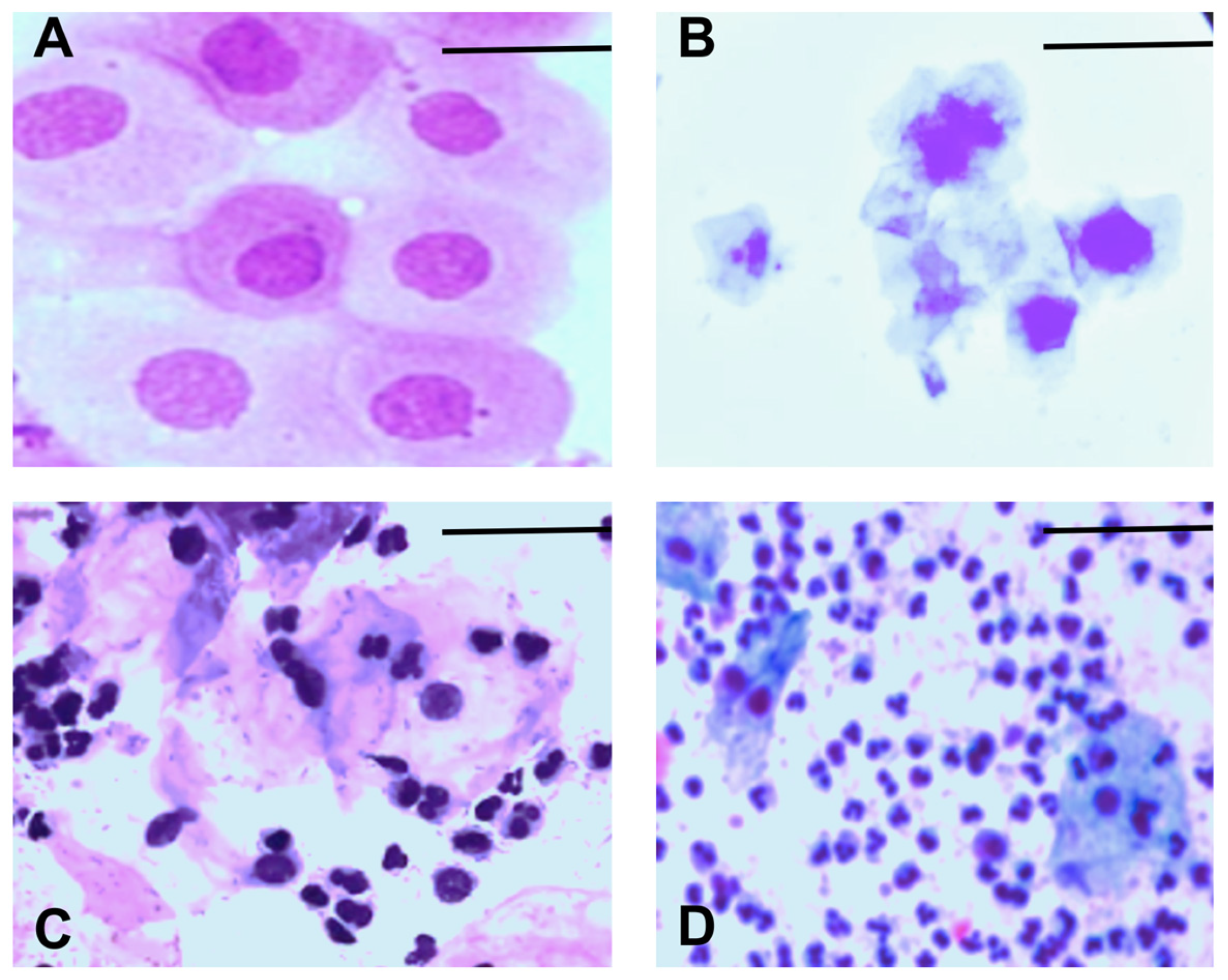
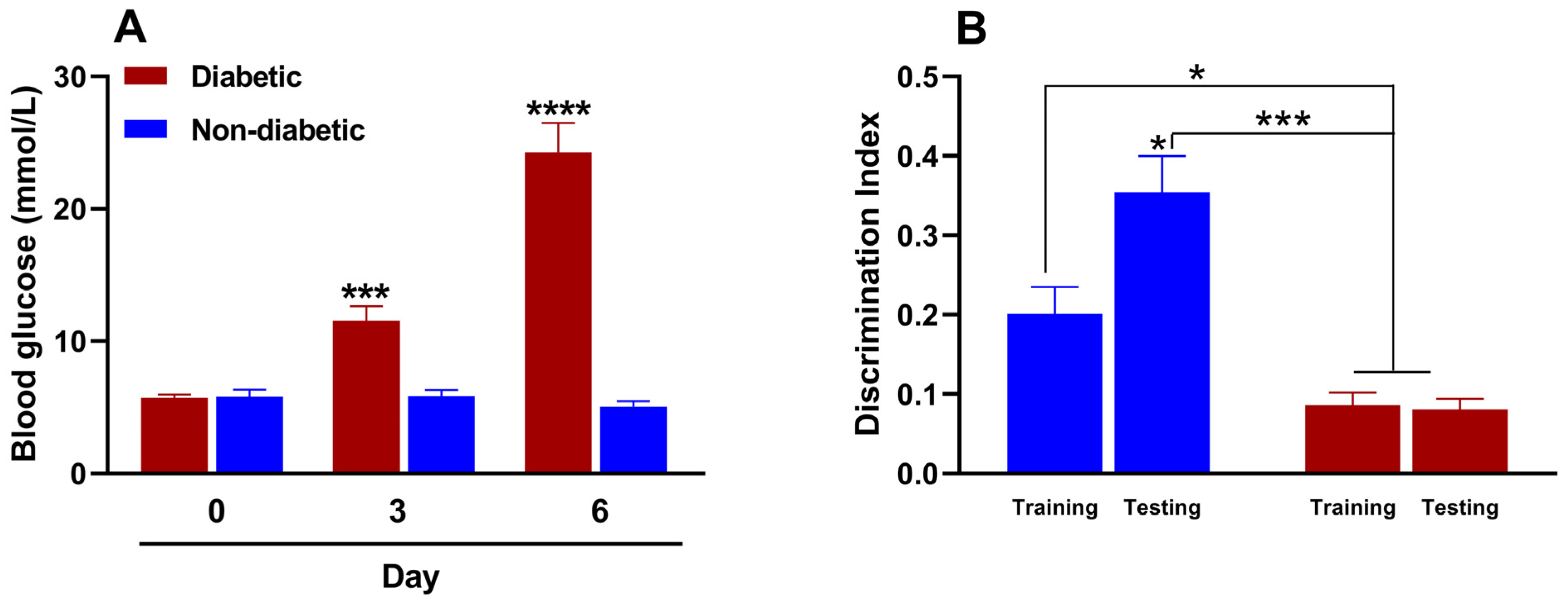
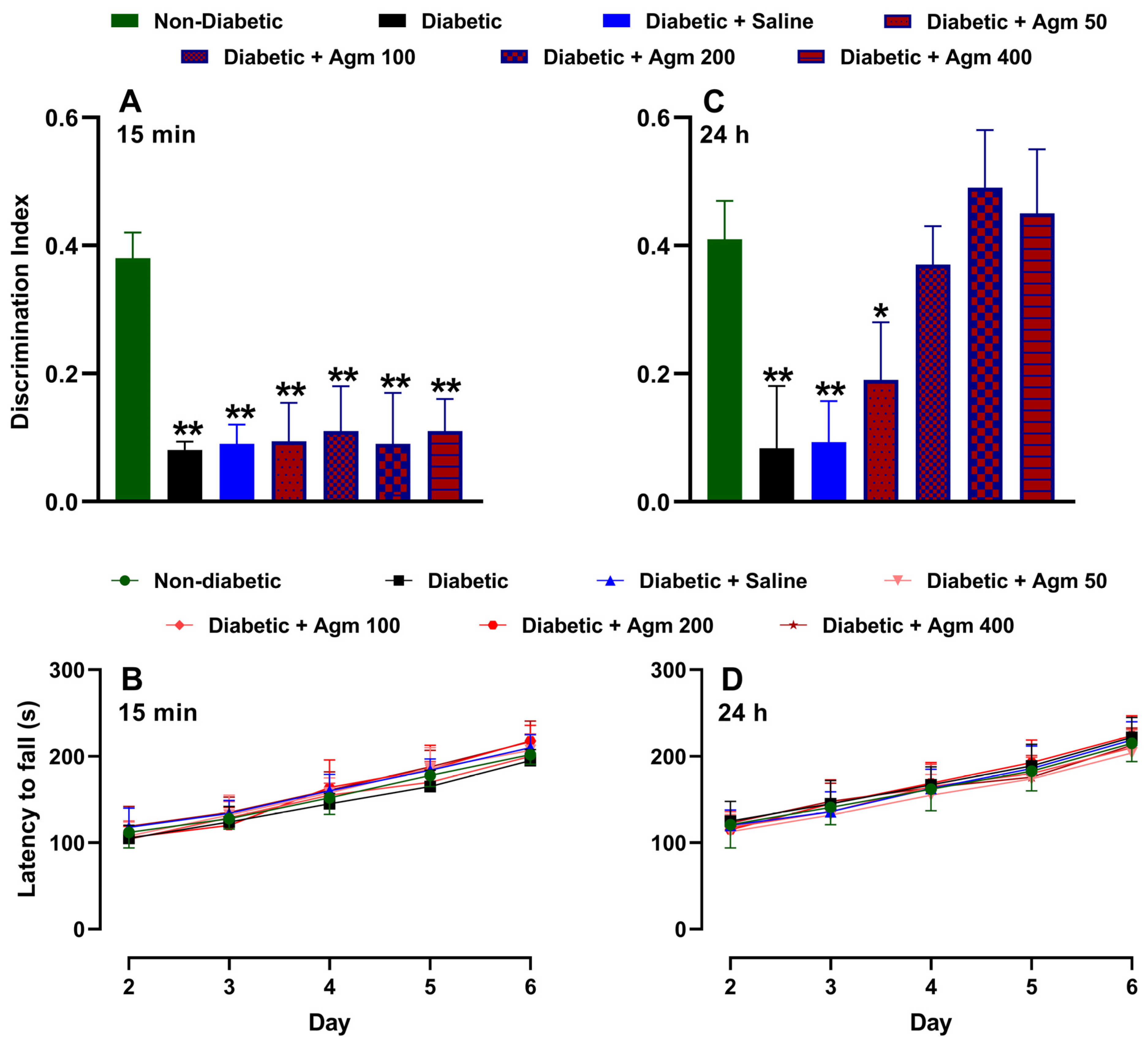
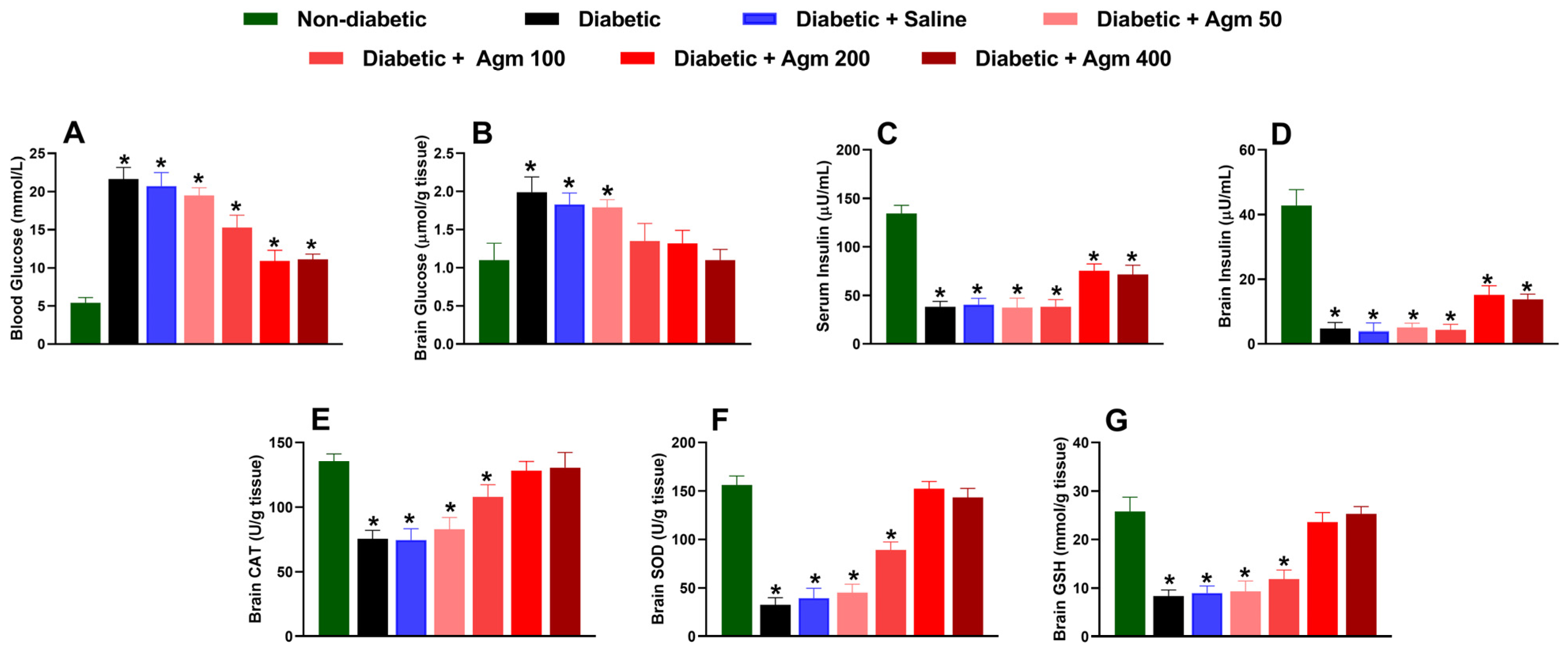

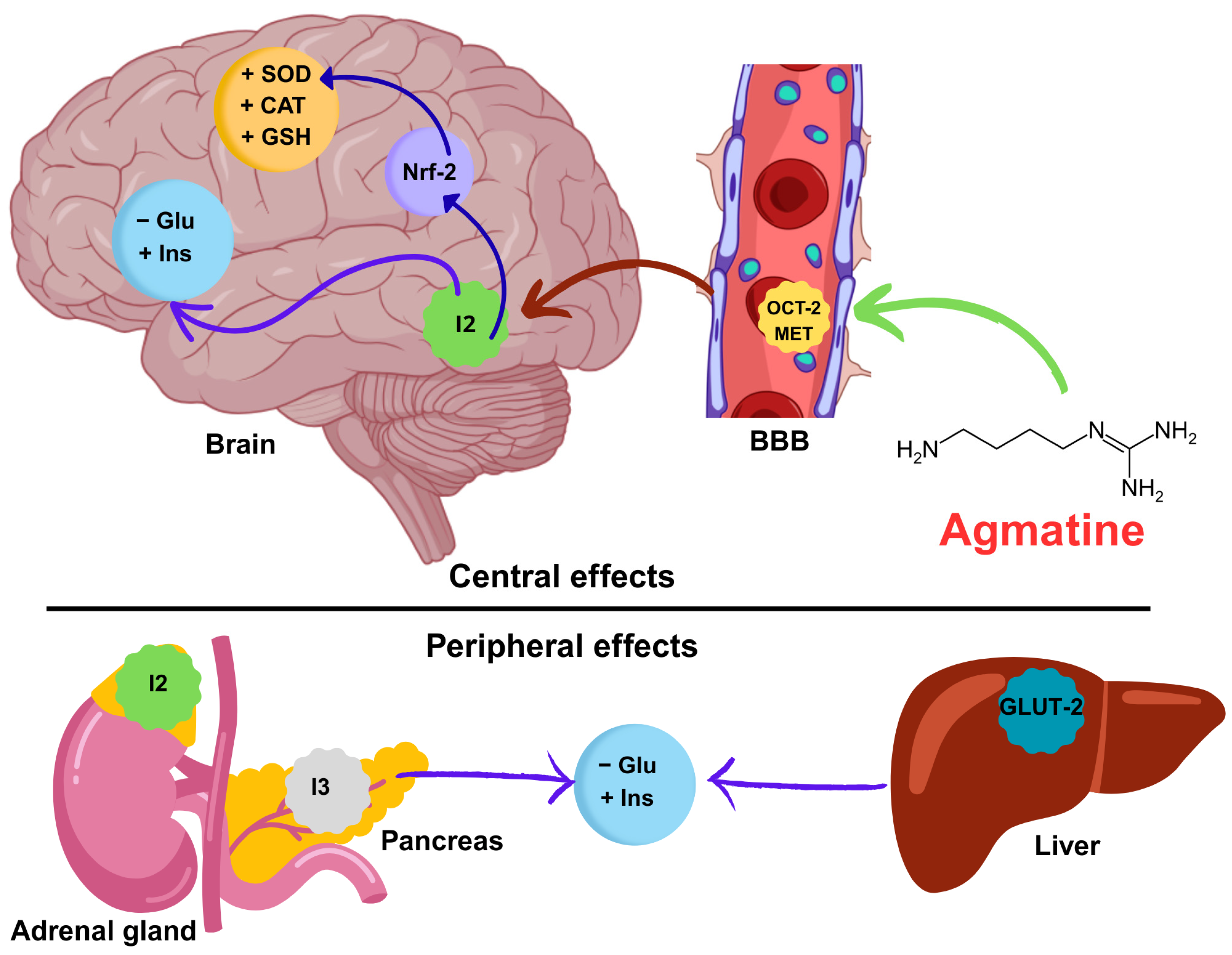
| Treatment | Proestrus | Estrus | Metestrus | Diestrus |
|---|---|---|---|---|
| % | ||||
| Group 1 | ||||
| STZ | 0 | 0 | 16.7 | 83.3 |
| CB | 0 | 0 | 33.3 | 66.7 |
| Group 2 | ||||
| ND | 0 | 0 | 0 | 100 |
| D | 0 | 0 | 33.3 | 66.7 |
| D-Saline | 0 | 0 | 16.7 | 83.3 |
| D-Agm 50 | 0 | 0 | 33.3 | 66.7 |
| D-Agm 100 | 0 | 0 | 16.7 | 83.3 |
| D-Agm 200 | 0 | 0 | 0 | 100 |
| D-Agm 400 | 0 | 0 | 16.7 | 83.3 |
| Group 3 | ||||
| ND-Saline | 0 | 0 | 33.3 | 66.7 |
| D | 0 | 0 | 0 | 100 |
| D-Saline | 0 | 0 | 16.7 | 83.3 |
| D-Agm 50 | 0 | 0 | 33.3 | 66.7 |
| D-Agm 100 | 0 | 0 | 0 | 100 |
| D-Agm 200 | 0 | 0 | 16.7 | 83.3 |
| D-Agm 400 | 0 | 0 | 33.3 | 66.7 |
| Group 4 | ||||
| D-Agm 200 + Saline | 0 | 0 | 16.7 | 83.3 |
| D-Agm 200 + DMSO | 0 | 0 | 0 | 100 |
| D-Agm 200 + rauwolscine | 0 | 0 | 33.3 | 66.7 |
| D-Agm 200 + AGN 192403 | 0 | 0 | 16.7 | 83.3 |
| D-Agm 200 + Idazoxan | 0 | 0 | 0 | 100 |
| D-Agm 200 + KU14R | 0 | 0 | 0 | 100 |
| Pearson Correlation (r) | ||||||||
|---|---|---|---|---|---|---|---|---|
| Variables | Discrimination Index | Blood Glucose | Brain Glucose | Serum Insulin | Brain Insulin | CAT | SOD | GSH |
| Discrimination index | 1.000 | |||||||
| Blood glucose | −0.552 | 1.000 | ||||||
| Brain glucose | −0.295 | 0.803 | 1.000 | |||||
| Serum insulin | 0.301 | −0.813 | −0.468 | 1.000 | ||||
| Brain insulin | 0.228 | −0.755 | −0.514 | 0.892 | 1.000 | |||
| CAT | 0.609 | −0.814 | −0.685 | 0.696 | 0.636 | 1.000 | ||
| SOD | 0.691 | −0.827 | −0.649 | 0.711 | 0.641 | 0.956 | 1.000 | |
| GSH | 0.611 | −0.726 | −0.567 | 0.644 | 0.612 | 0.929 | 0.943 | 1.000 |
Disclaimer/Publisher’s Note: The statements, opinions and data contained in all publications are solely those of the individual author(s) and contributor(s) and not of MDPI and/or the editor(s). MDPI and/or the editor(s) disclaim responsibility for any injury to people or property resulting from any ideas, methods, instructions or products referred to in the content. |
© 2025 by the authors. Licensee MDPI, Basel, Switzerland. This article is an open access article distributed under the terms and conditions of the Creative Commons Attribution (CC BY) license (https://creativecommons.org/licenses/by/4.0/).
Share and Cite
Cobos-Puc, L.E.; Aguayo-Morales, H. Agmatine Mitigates Diabetes-Related Memory Loss in Female Mice by Targeting I2/I3 Imidazoline Receptors and Enhancing Brain Antioxidant Defenses. Antioxidants 2025, 14, 837. https://doi.org/10.3390/antiox14070837
Cobos-Puc LE, Aguayo-Morales H. Agmatine Mitigates Diabetes-Related Memory Loss in Female Mice by Targeting I2/I3 Imidazoline Receptors and Enhancing Brain Antioxidant Defenses. Antioxidants. 2025; 14(7):837. https://doi.org/10.3390/antiox14070837
Chicago/Turabian StyleCobos-Puc, Luis E., and Hilda Aguayo-Morales. 2025. "Agmatine Mitigates Diabetes-Related Memory Loss in Female Mice by Targeting I2/I3 Imidazoline Receptors and Enhancing Brain Antioxidant Defenses" Antioxidants 14, no. 7: 837. https://doi.org/10.3390/antiox14070837
APA StyleCobos-Puc, L. E., & Aguayo-Morales, H. (2025). Agmatine Mitigates Diabetes-Related Memory Loss in Female Mice by Targeting I2/I3 Imidazoline Receptors and Enhancing Brain Antioxidant Defenses. Antioxidants, 14(7), 837. https://doi.org/10.3390/antiox14070837









